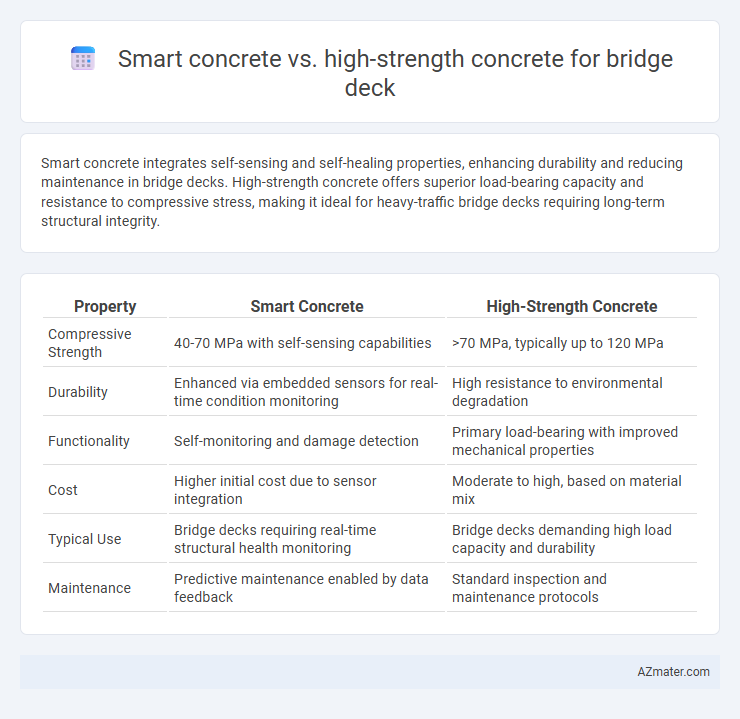Smart concrete integrates self-sensing and self-healing properties, enhancing durability and reducing maintenance in bridge decks. High-strength concrete offers superior load-bearing capacity and resistance to compressive stress, making it ideal for heavy-traffic bridge decks requiring long-term structural integrity.
Table of Comparison
| Property | Smart Concrete | High-Strength Concrete |
|---|---|---|
| Compressive Strength | 40-70 MPa with self-sensing capabilities | >70 MPa, typically up to 120 MPa |
| Durability | Enhanced via embedded sensors for real-time condition monitoring | High resistance to environmental degradation |
| Functionality | Self-monitoring and damage detection | Primary load-bearing with improved mechanical properties |
| Cost | Higher initial cost due to sensor integration | Moderate to high, based on material mix |
| Typical Use | Bridge decks requiring real-time structural health monitoring | Bridge decks demanding high load capacity and durability |
| Maintenance | Predictive maintenance enabled by data feedback | Standard inspection and maintenance protocols |
Introduction to Smart Concrete and High-Strength Concrete
Smart concrete integrates sensors and self-sensing capabilities to monitor structural health, providing real-time data on stress, strain, and environmental conditions in bridge decks. High-strength concrete achieves compressive strengths typically above 6,000 psi (41 MPa), enhancing load-bearing capacity and durability under heavy traffic and environmental stress. Both materials serve critical roles in bridge deck construction, with smart concrete enabling proactive maintenance and high-strength concrete ensuring structural resilience.
Key Properties and Performance Metrics
Smart concrete for bridge decks incorporates self-sensing capabilities and crack-healing properties, enhancing durability and real-time structural health monitoring. High-strength concrete offers superior compressive strength, typically above 50 MPa, providing excellent load-bearing capacity and resistance to heavy traffic impacts. Performance metrics for smart concrete emphasize long-term serviceability and damage detection, while high-strength concrete prioritizes maximum strength and reduced maintenance frequency under high-stress conditions.
Material Composition and Technology
Smart concrete for bridge decks incorporates advanced materials such as self-sensing fibers, nano-silica, and conductive polymers to enable real-time structural health monitoring and improved durability. High-strength concrete primarily relies on optimized mix designs with low water-cement ratios, silica fume, and high-quality aggregates to achieve compressive strengths exceeding 6000 psi, enhancing load-bearing capacity. The integration of smart technology in smart concrete supports proactive maintenance and longevity, while high-strength concrete emphasizes mechanical performance under heavy loads.
Durability and Longevity in Bridge Decks
Smart concrete incorporates self-healing properties and embedded sensors that enhance durability by autonomously repairing microcracks, reducing maintenance needs in bridge decks. High-strength concrete offers superior compressive strength and resistance to heavy loads but may be more susceptible to cracking over time without self-healing capabilities. The integration of smart concrete technology significantly extends the longevity of bridge decks by minimizing deterioration and enabling real-time structural health monitoring.
Load-Bearing Capacity Comparison
Smart concrete incorporates nanomaterials and self-healing agents that enhance its load-bearing capacity beyond traditional high-strength concrete by improving crack resistance and durability under dynamic traffic loads. High-strength concrete achieves superior compressive strength, typically above 70 MPa, enabling it to support heavy loads, but may lack the adaptive stress distribution features of smart concrete. Studies indicate smart concrete's ability to maintain structural integrity under cyclic loading conditions results in longer service life and reduced maintenance for bridge decks compared to conventional high-strength concrete.
Crack Detection and Self-Healing Capabilities
Smart concrete incorporates embedded sensors enabling real-time crack detection, significantly enhancing maintenance efficiency for bridge decks. High-strength concrete offers superior load-bearing capacity but lacks inherent self-healing properties, making it more prone to undetected microcracks. Self-healing smart concrete integrates microcapsules or bacteria-based agents that autonomously repair cracks, reducing long-term deterioration and extending bridge lifespan.
Installation and Construction Methods
Smart concrete incorporates embedded sensors and self-sensing technology, enabling real-time monitoring of structural health during installation, which enhances precision and reduces the risk of defects in bridge deck construction. High-strength concrete requires specialized mixing and placement techniques, including careful control of curing conditions to achieve optimal compressive strength and durability, often involving advanced formwork and longer setting times. Installation of smart concrete facilitates proactive maintenance strategies through integrated data collection, whereas high-strength concrete focuses on maximizing load-bearing capacity through robust mechanical properties.
Cost Analysis and Lifecycle Value
Smart concrete for bridge decks integrates sensors that enable real-time structural health monitoring, potentially reducing long-term maintenance costs by detecting damages early. High-strength concrete, while more expensive upfront due to advanced materials and processes, offers superior load-bearing capacity and durability, minimizing repair frequency and extending service life. Evaluating lifecycle value reveals that smart concrete's upfront investment in technology may yield cost savings through proactive maintenance, whereas high-strength concrete relies on material strength to reduce lifecycle expenses by enhancing structural longevity.
Environmental Impact and Sustainability
Smart concrete incorporates self-healing properties and embedded sensors that extend the lifespan of bridge decks, reducing maintenance frequency and resource consumption compared to traditional high-strength concrete. High-strength concrete offers enhanced load capacity with less material volume but often requires energy-intensive production methods and higher CO2 emissions. Utilizing smart concrete promotes sustainability by minimizing environmental impact through reduced repair cycles and optimizing resource efficiency in bridge deck construction.
Future Trends in Bridge Deck Construction
Smart concrete integrates sensors that monitor structural health in real-time, enhancing preventive maintenance for bridge decks, while high-strength concrete offers superior load-bearing capacity and durability under heavy traffic conditions. Future trends emphasize the convergence of these technologies, with smart high-strength concrete enabling both enhanced performance and intelligent monitoring for longer service life. Innovations in nanomaterials and IoT integration will likely drive the adoption of smart concrete systems in bridge deck construction, optimizing safety and reducing lifecycle costs.

Infographic: Smart concrete vs High-strength concrete for Bridge deck
 azmater.com
azmater.com